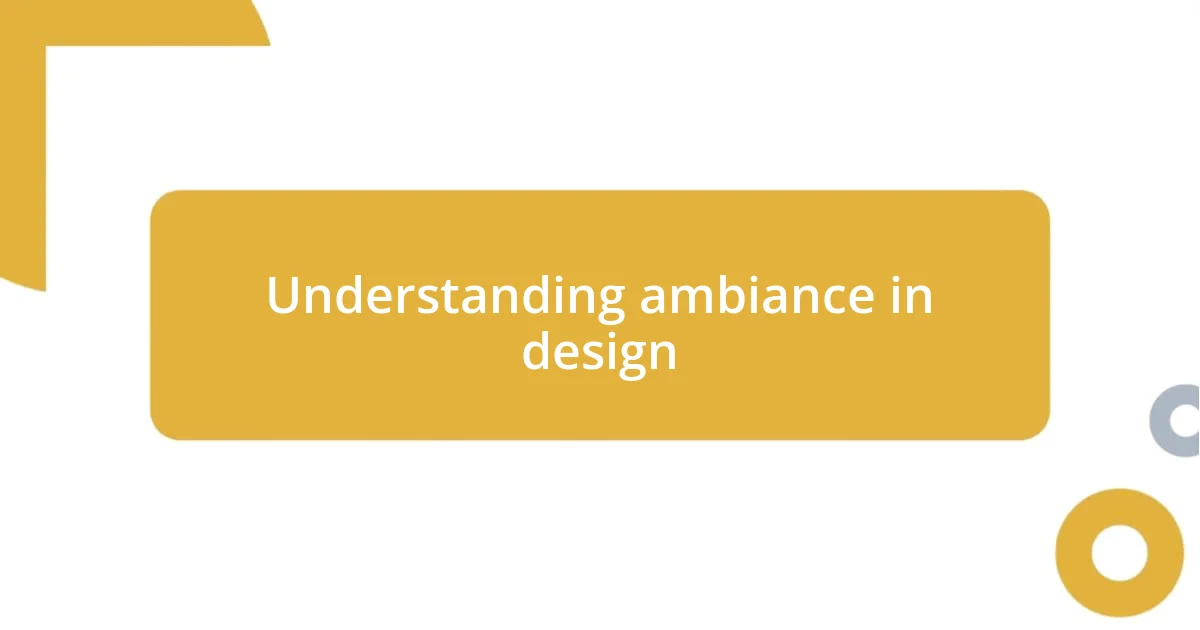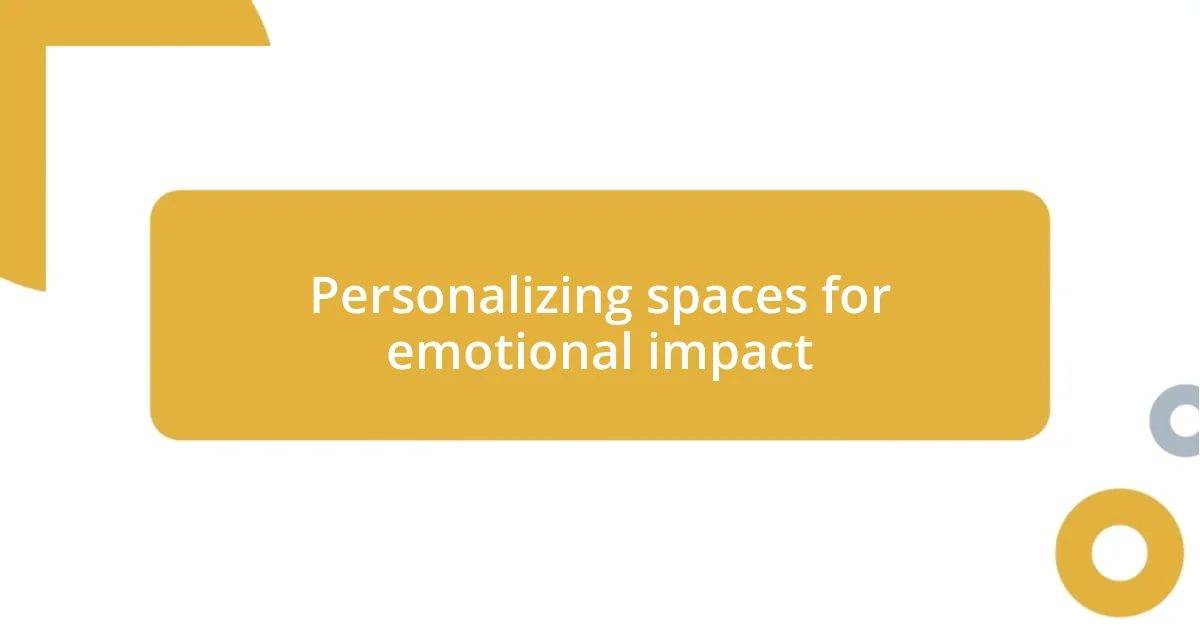Key takeaways:
- Ambiance encompasses visual, auditory, and olfactory elements, deeply influencing our emotional experiences in various spaces.
- Color schemes significantly affect our mood, with specific colors evoking feelings such as calmness (blue) or excitement (red).
- Personalization through textures, materials, and personal items enhances emotional connections, transforming spaces into comforting sanctuaries.

Understanding ambiance in design
Ambiance is more than just the visual aspects of a space; it affects how we feel when we enter a room. I remember walking into a cozy café filled with soft, warm lighting and comfortable seating. It instantly invited me to slow down and enjoy my coffee, a contrast to the stark, fluorescent-lit office spaces I often frequent. Isn’t it fascinating how much control we have over our emotional experiences through design choices?
When I think about ambiance, I often consider how sound plays a crucial role too. One evening, I attended a restaurant where soft background music seemed to wrap around us, creating an intimate atmosphere for laughter and conversation. It made me realize that the right sounds can elevate a space far beyond its physical dimensions. Have you ever noticed how certain sounds can transport you back to fond memories, simply through ambiance?
Then there’s the element of scent, which might be the most underrated aspect of design. A specific fragrance, like fresh-baked bread or sandalwood, can evoke nostalgia and comfort. I once entered a home filled with the smell of lavender and felt an unexpected wave of calm wash over me. It’s so intriguing to think about how our senses intertwine to shape our perception of a space. What kinds of sensations do you find most compelling in your favorite environments?

Importance of color schemes
Color schemes play a pivotal role in shaping the atmosphere of any space. I’ve often noticed how a room painted in deep blues can evoke feelings of calm and peace. In contrast, vibrant reds can instill a sense of energy and excitement. It’s interesting to think about how these visual cues can subconsciously influence our emotions and behaviors. Have you ever walked into a room and instantly felt a shift in your mood based on its color?
When choosing a color scheme, it’s essential to consider the emotions you want to elicit. For instance, I once redecorated my home office with soft greens, which surprisingly made me feel more focused and productive. The psychological impact of color is profound—I believe it can even make the difference between a space that feels welcoming and one that seems impersonal or cold. What colors resonate with you for different moods?
Ultimately, color choices can strengthen personal expression. Take, for example, a friend’s bright, sunlit yellow kitchen. The color radiates warmth and happiness, making it a perfect place for gatherings and family meals. Colors have a remarkable ability to transform spaces, creating environments that either soothe or invigorate. Can you share a color experience that made an impact on you?
| Color | Emotional Impact |
|---|---|
| Blue | Calm & Peace |
| Red | Energy & Excitement |
| Green | Focus & Productivity |
| Yellow | Happiness & Warmth |

Role of lighting in ambiance
Lighting plays an instrumental role in defining the ambiance of a space. I vividly recall visiting a boutique hotel adorned with various types of lighting, including elegant chandeliers and soft wall sconces. The interplay of warm light created an inviting glow that made me feel instantly relaxed, setting the tone for a laid-back evening. It’s incredible how lighting can establish a place’s character and influence the mood of its visitors.
- The brightness of lighting can energize or calm down a space.
- Warm lighting typically fosters feelings of comfort and relaxation.
- Dim lighting can create intimacy, ideal for romantic dinners or quiet conversations.
- Natural light, of course, has the power to boost our mood and productivity.
- Accent lighting can highlight artwork or decor, adding an element of intrigue.
Each of these aspects illustrates how vital lighting is in crafting the feeling we experience in a space. I once hosted a small gathering at home, strategically placing string lights in my backyard. The soft twinkle created a magical atmosphere that prompted laughter and connection among friends, showing me how a simple change in lighting can transform a regular evening into a memorable occasion. The right lighting can truly elevate our experiences and shape our emotions in profound ways.

Incorporating textures and materials
Incorporating textures and materials is where a space starts to come alive. I can recall the first time I walked into a loft adorned with exposed brick walls, complemented by sleek leather furniture. The contrast between the rugged texture of the brick and the smooth leather created an intriguing depth that drew me in. Isn’t it fascinating how juxtaposing different materials adds layers of interest?
The choice of textures can vividly influence the feel of a room. For example, when I transitioned my bedroom from standard linens to a mix of chunky knit throw pillows and a soft velvety blanket, it transformed the overall comfort level. I never realized how much coziness could stem from tactile experiences. Have you ever noticed how you gravitate toward certain materials because they provoke a specific comforting sensation?
Natural materials, in particular, seem to have an intuitive appeal. I find that spaces enriched with wooden accents exude warmth, making people feel more at home. I decorated my living room with a reclaimed wood coffee table, and the first compliments I received seemed to echo the idea that well-chosen materials can resonate emotionally. What materials make you feel grounded and connected?

Creating focal points in spaces
Creating focal points in a space can drastically change how we perceive and interact with our environments. I remember redoing my living room and deciding that a bold, oversized piece of art would be the centerpiece. It was astonishing how that single canvas not only drew the eye but also set the tone for conversation and connection. Have you ever noticed how your gaze unconsciously gravitates toward standout features?
The beauty of a focal point is that it can come from various sources—be it an eye-catching sculpture, a striking piece of furniture, or even an architectural element like a fireplace. When I first placed a vintage armchair in my reading nook, it became a cozy haven, beckoning me to sit and unwind with a book. The chair didn’t just serve a purpose; it transformed the entire corner into a welcoming retreat. What items in your home invite you to linger?
Additionally, the way you position these focal points can enhance their impact. I once arranged my dining table in alignment with a large window overlooking my garden, effectively marrying the indoors with the vibrant outdoor scenery. This alignment drew attention to both the table and the view, creating a harmonious flow that encouraged gatherings. Isn’t it amazing how thoughtful placement can invite people to engage with a space in a more meaningful way?

Personalizing spaces for emotional impact
Personalizing spaces deeply affects the emotions we associate with them. I recall a small nook I once created just off my kitchen. By adding string lights and a well-loved armchair, it transformed into my go-to spot for morning coffee. The soft glow and cozy seating made the space feel like a warm embrace—wouldn’t you agree that certain areas in our homes can become little sanctuaries for the soul?
In my experience, incorporating personal items plays a pivotal role in evoking emotions. I have a collection of photographs displayed on a gallery wall, featuring snapshots from my travels with friends and family. Each image brings back a flood of memories, making that corner feel not just decorative but alive with stories and laughter. Have you ever noticed how just a simple photo can shift your mood or transport you back in time?
Colors also significantly influence how we feel in a space. I recently painted my office a calming shade of soft blue, and it’s like stepping into a tranquil oasis. This intentional choice has enhanced my focus and creativity, allowing me to dive deeper into my work. Isn’t it incredible how a simple color can shift our mindset and emotional engagement with an environment?















